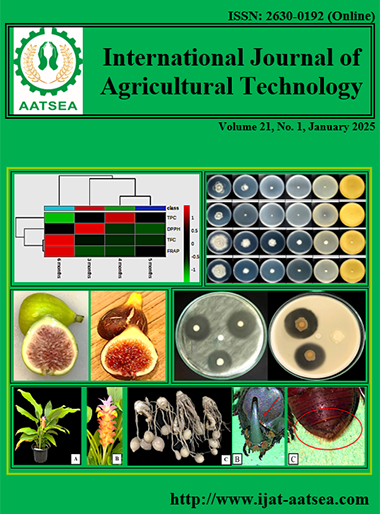Assessing the impact of frequent floodings on the soil quality of paddy fields: multidimensional scaling approach
Main Article Content
Abstract
The increase in flood frequency due to climate change may cause a decrease in the soil quality of paddy fields. The results of the study showed that the multidimensional scaling approach can be used to calculate the soil quality index and assess the impact of frequent flooding on soil quality of paddy fields. Several physical, chemical and biological characteristics of the soil were not significantly different in the paddy fields that were often flooded if compared to those that were not flooded, except for exchangeable kalium content. Frequent flooding on the paddy fields tends to decrease the Soil Quality Index. The Soil Quality Index of paddy fields have a tendency to decrease if the paddy fields were often flooded, either by standing water from rivers or sea water. The Soil Quality Index category of paddy fields that were not flooded was good (86.1). While the Soil Quality Index category of paddy fields that were flooded by rivers was average (62.0) and paddy fields that were flooded by sea water was slightly good (75.8). The leverage attributes of the soil characteristics are exchangeable natrium and kalium, and total phosphorus.
Article Details

This work is licensed under a Creative Commons Attribution-NonCommercial-NoDerivatives 4.0 International License.
References
Agustina, C., Rayes, M. L. and Kuntari, M. (2020). Mapping of nitrogen, phospor and potassium nutrients on rice field in Turen District, Malang Regency. Jurnal Tanah dan Sumberdaya Lahan, 7:273-282.
BPT (2005). Technical guidances for chemical analysis of soil, plants, water and fertilizers (in Indonesian). Bogor, Balai Penelitian Tanah, Badan Penelitian dan Pengembangan Pertanian.
BPS (2024). Bengkulu Province in Figures 2024. Bengkulu, Badan Pusat Statistik, pp.298-299.
BPS (2019). Bengkulu Province in Figures 2019. Bengkulu, Badan Pusat Statistik, pp.235-236.
Clarke, K. R. (1993). Non-parametric multivariate analysis of changes in community structure. Australian Journal of Ecology, 18:117-143.
Doran, J. W. and Parkin, T. B. (1996). Quantitative indicators of soil quality: a minimum data set, in Methods for Assessing Soil Quality, SSSA Special Publication, 49.
Doran, J. W. and Zeiss, M. R. (2000). Soil health and sustainability: managing the biotic component of soil quality. Applied Soil Ecology, 15:3-11.
Gomez, K. A. and Gomez, A. A. (1984). Statistical procedures for agricultural research. New York, John Wiley & Sons, pp.207-215.
Grimme, H. (1985). The dynamics of potassium in the soil-plant system. In Potassium in agricultural system of the humic tropics. Proceeding of the 19th Colloqium of the International Potash Institute, Bangkok, Thailand, pp.127-154.
Jannah, R., Dhonanto, D. and Hakim, H. F. (2021). Soil quality mapping using geographic information system analysis in Samarinda City (in Indonesian). Jurnal Agroekoteknologi Tropika Lembab, 4:50-61.
Karlen, D. L. (2004). Soil quality as an indicator of sustainable tillage practices. Soil and Tillage Research, 78:129-130.
Karlen, D. L., Andrews, S. S. and Doran, J. W. (2001). Soil quality: current concepts and applications. Advances in Agronomy, 74:1-40.
Kasno, A., Setyorini, D., Widowati, l. R. and Rostaman, T. (2021). Characteristics evaluation, nutrition contribution of irrigation water and straw toward response to nutritional potassium fertilization in paddy field. AGRIC, 33:189-198.
Kavanagh, P. and Pitcher, T. J. (2004). Implementing microsoft excel software for rapfish: a technique for the rapid appraisal of fisheries status. Fisheries Center Research Report, 12:1-75.
Kaya, E. (2014). The effect of organic fertilizer and NPK fertilizer on soil pH and available K and K absorption, growth, and yield of wet land rice (Oryza sativa L). Buana Sains, 14:113-122.
Lal, R. (1994). Methods and guidelines for assessing sustainable use of soil and water Resource in the tropics. Soil Management Support Service USDA Soil Consevation Service. SMSS Technical Monograph No.21, pp.57-59.
Makarim, A. K. and Ikhwani. (2011). Innovation and strategies to reduce the impact of flooding on rice farming (in Indonesian). Jurnal Ilmu Tanah dan Lingkungan, 13:35-41.
MoA (2024). Agricultural statistics database. Jakarta, Ministry of Agriculture Data Center and Information System. Retried from https://bdsp2.pertanian.go.id/bdsp/id/home.html
Mukherjee, A. and Lal, R. (2014). Comparison of soil quality index using three methods. PLoS ONE, 9:e105981.
Obade, V. P. (2017). Quantifying the interactions of land management practices and agricultural productivity using a soil quality index. Soil Use and Management, 33:639-652.
Prayoga, M. K., Adinata, K., Rostini, N., Setiawati, M. R., Simarmata, T. and Stober, S. (2017). Floating rice as the farmers innovation to the impact of climate change in Pangandaran (in Indonesian). Seminar Nasional Dan Gelar Teknologi Padi, 2017:1-11.
Pitcher, T. J and Preikshot, D. (2001). Rapfish: a rapid appraisal technique to evaluate the sustainabilty status of fisheries. Fisheries Research, 49:225-270.
Rachman, L. M., Hazra, F. and Anisa, R. (2020). Assessment of physical and chemical properties and their quality of soil of marginal paddy field (in Indonesian). Jurnal Tanah dan Sumberdaya Lahan, 7:225-236.
Vasu, D., Singh, S. K., Ray, S. K., Duraisami, V. P., Tiwary, P., Chandran, P., Nimkar, A. M. and Anantwar, S. G. 2016. Soil quality index (SQI) as a tool to evaluate crop productivity in semi-arid Deccan plateau, India. Geoderma, 282:70-79.
Zhang, Y., Wang, L., Jiang, J., Zhang, Z. and Zhang, M. (2022). Application of soil quality index to determine the effects of different vegetation types on soil quality in the Yellow River Delta wetland. Ecological Indicators, 141:1-11.


